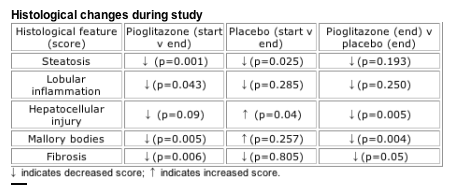 |
 |
 |
| |
Pioglitazone Improved Metabolics & Liver Injury in Non-diabetics with NASH
|
| |
| |
A randomized, double blind, placebo controlled trial of one year of pioglitazone in non-diabetic subjects with nonalcoholic steatohepatitis
Reported by Jules Levin
AASLD, Nov 2-6, 2007, Boston, MA
G. P. Aithal1; J. A. Thomas1; P. Kaye2, 1; A. Lawson1; S. D. Ryder1; A. S. Austin4; J. G. Freeman4, 1; L. Morgan3; W. Jonathan5
1. Wolfson Digestive Diseases Centre, University Hospital, Nottingham, United Kingdom.
2. Histopathology, University Hospital, Nottingham, United Kingdom.
3. Clinical Chemistry, Nottingham University, Nottingham, United Kingdom.
4. Gastroenterology, Derby Hospital, Derby, United Kingdom.
5. Diabetes Centre, Selly Oak Hospital, Birmingham, United Kingdom.
"Pioglitazone therapy over a 12 month period in non-diabetic subjects with NASH resulted in improvements in metabolic and histological parameters, most notably liver injury and fibrosis."
Background:
Nonalcoholic steatohepatitis (NASH) is a leading cause of chronic liver disease for which there is currently limited therapy. Thiazolidinediones have demonstrated some promise in treating NASH in diabetics. Their insulin sensitizing, anti-inflammatory and anti-fibrotic actions support their use in non-diabetic patients with NASH.
Aim:
To evaluate pioglitazone in the treatment of non-diabetic patients with NASH.
Methods:
We randomized 74 non-diabetic patients (45 male; median age 54 yr) with histologically proven NASH to 12 months of standard diet, exercise and either placebo or pioglitazone (30 mg/day). Of these, 61 patients (30 placebo, 31 pioglitazone) had liver biopsies both at the start and end of the study. Histological change was scored by a single pathologist who was blinded to all the information including the timing of the biopsy.
Results:
In the placebo group, diastolic BP (p<0.001) and ALT (p=0.016) decreased, while glucose (p=0.002), HbA1c (p=0.045) and serum markers of liver fibrosis (hyaluronic acid (p=0.012), tissue inhibitor of metalloproteinase (TIMP)-1 (p=0.008), aminoterminal propeptide of type III collagen (p=0.015)) increased over the study period.
In the pioglitazone group, diastolic BP (p=0.02), transaminases (ALT & GGT p<0.001) and ferritin (p=0.016) decreased, while subjects gained weight (p=0.004) over the study period.
Comparing the pioglitazone group against placebo, there was an increase in weight (+2.77 v -0.55kg, p=0.042) and reduction in glucose (p=0.021), HbA1c (p=0.006), insulin C peptide (p=0.015), ALT (p=0.009), GGT (p=0.002), ferritin (p=0.012), and TIMP-1 (p=0.015) associated with pioglitazone therapy.
The histological changes during the study are summarised in the table.
Conclusions:
Pioglitazone therapy over a 12 month period in non-diabetic subjects with NASH resulted in improvements in metabolic and histological parameters, most notably liver injury and fibrosis. Larger extended trials are justified to assess the long-term efficacy of pioglitazone in this patient group.

|
| |
|
 |
 |
|
|